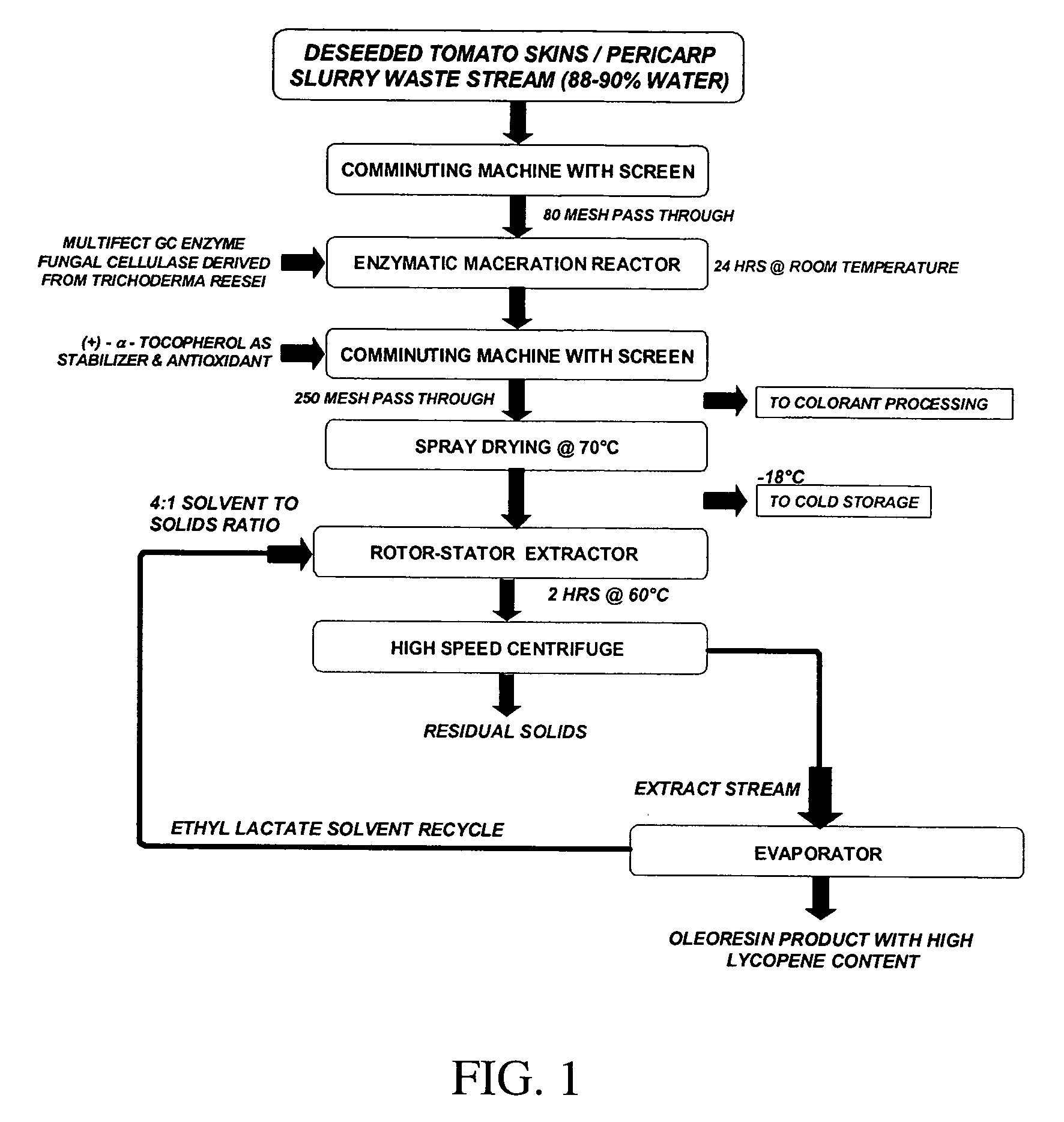Extraction of carotenoids from plant material
a technology of plant material and carotenoids, which is applied in the direction of plant/algae/fungi/lichens, biocide, plant/algae/fungi/lichens ingredients, etc., can solve the problems of neither dichloromethane nor hexane being environmentally friendly, and achieve the effects of reducing the degradation of carotenoids, and increasing the accessibility of extraction solvents
- Summary
- Abstract
- Description
- Claims
- Application Information
AI Technical Summary
Benefits of technology
Problems solved by technology
Method used
Image
Examples
example 1
[0083]One-hundred grams of alkali-peeled, deseeded tomato skins were homogenized for 1 min, using a Waring blender. Multifect GC cellulase was added to a final concentration of 300 IU / g of tomato homogenate. The pH was adjusted to 4.5 with HCl and the mixture incubated in a shaking water bath at 55° C. for 24 h. The resulting fine paste was lyophilized at −20° C. until dry. The dry product was then ground in a mortar and pestle with dry ice (CO2) and passed through a No. 200-mesh sieve. The moisture content was determined to be 5%, using a microwave solids and moisture analyzer (CEM Corporation). Three grams of the resulting powder were extracted using ethyl lactate:ethanol (99:1) at 60° C. in a 4:1 (solvent:solid) ratio in a shaking water bath. The tomato powder was extracted 3 times for 2 h each. The lycopene extract was separated from the solids by centrifugation and the solvent mixture replaced, maintaining the 4:1 ratio. The lycopene content of the extract was determined immedi...
example 2
[0084]Tomato pomace (9 pomace:1 water) was homogenized for 1 min, using a Waring blender. Multifect GC cellulase was added to a final concentration of 300 IU / g of tomato homogenate. The pH was adjusted to 4.5 with HCl and the mixture incubated in a shaking water bath at 55° C. for 4 h, after which most of the liquid was removed by centrifugation. The resulting slurry was then lyophilized at −20° C. until dry. The dry product was then ground in a mortar and pestle with dry ice (CO2) and passed through a No. 60-mesh sieve. The moisture content was determined to be approximately 5%, using a microwave solids and moisture analyzer (CEM Corporation). One-half g of the resulting powder was extracted using ethyl lactate / ethanol (99:1) at 60° C. at a ratio of 8 solvent:1 solid for 2 h in a shaking water bath. The lycopene content of the extract was measured immediately by UV-VIS spectroscopy at 470 nm and found to be 3.5 μg lycopene / g dry wt.
example 3
[0085]Extraction from Gac aril (Momordica cochinchinensis). A dehydrated, weighed amount of thawed preground GAC aril (oily fleshy red pulp that surrounds the seed) was extracted with ethyl lactate / ETOH (ratio of ethyl lactate to ethanol was 8:1, v / v). The total volume of the sample was measured and analyzed via UV spectroscopy. 3 ml samples were dried down under N2 to a residue that was subsequently resuspended in 2 mls THF and analyzed via HPLC (results below):
[0086]
Carotenoidconc. (μg / g)trans-lycopene70.26cis-lycopene67.73trans-Bcarotene66.74cis-B carotenesa carotene37.45all lycopene(cis + trans)138.00all carotene169.65
PUM
 Login to View More
Login to View More Abstract
Description
Claims
Application Information
 Login to View More
Login to View More - R&D
- Intellectual Property
- Life Sciences
- Materials
- Tech Scout
- Unparalleled Data Quality
- Higher Quality Content
- 60% Fewer Hallucinations
Browse by: Latest US Patents, China's latest patents, Technical Efficacy Thesaurus, Application Domain, Technology Topic, Popular Technical Reports.
© 2025 PatSnap. All rights reserved.Legal|Privacy policy|Modern Slavery Act Transparency Statement|Sitemap|About US| Contact US: help@patsnap.com


